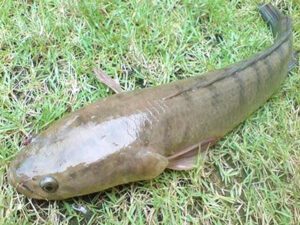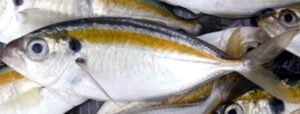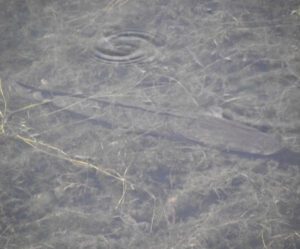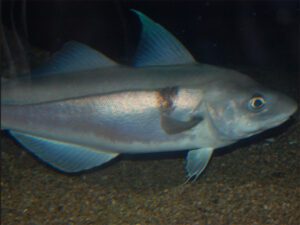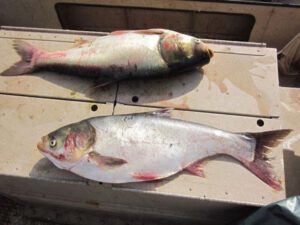The Grass carp fish (Ctenopharyngodon idella) is a popular carp fish species which is cultivated throughout the world. It’s largest reported production is over five million tones per year globally. It is native to eastern Asia, and is a large herbvorous freshwater fish species of the Cyprinidae family. And it is the only species of the genus Ctenopharyngodon. It’s native range is from northern Vietnam to the Amur River on the Siberia-China border.
Grass carp fish is cultivated in China for long time for food. But it was also introduced in the United States and Europe for aquatic weed control. This fish species is mainly found on turbid rivers and associated floodplain lakes. It is also called White Amur in the United States (which is derived from the Amur River, where this fish is probably native but has never been abundant). But it is not to be confused with the white Amur bream, which is not a particularly close relative. The Grass carp fish species has been introduced to many countries and available throughout the world.
Countries and territories in the Northern Hemisphere where this fish is available include India, Bangladesh, Israel, Japan, Taiwan, Mexico, Malaysia, the Philippines, the United States, the Netherlands, Denmark, Romania, Switzerland, Czechoslovakia, Sweden, Yugoslavia, Italy, West Germany, the United Kingdom, Poland and France. And in the Southern Hemisphere, they have been introduced to South Africa, Argentina, Fiji, New Zealand, Venezuela and Australia.
Grass carp fish species was first imported in the United States in the year of 1963 from Taiwan and Malaysia to aquaculture facilities in Alabama and Arkansas. The first release is believed to have been an accidental escape in 1966 from the US Fish and Wildlife Service’s Fish Farming Experimental Station in Stuttgart, Arkansas, followed by planned introductions beginning in 1969.
The species had been introduced to 40 states by the 1970s, and it is still stocked in many states as an effective biocontrol for undesirable aquatic vegetation. Read some more information about the Grass carp fish below.
Characteristics
Body of the Grass carp fish is elongated, chubby and torpedo-shaped. Color of the body is dark olive, shading to brownish-yellow on the sides, with a white belly and large, slightly outlined scales. The terminal mouth is slightly oblique with non-fleshy, firm lips and no barbels. The complete lateral line of these fishes contains 40 to 42 scales.
They have broad, ridged, pharyngeal teeth which are arranged in a 2, 4-4, 2 formula. Their anal fin is set closer to the tail than most cyprinids, and the dorsal fin has eight to 10 soft rays. The Grass carp fish can grow very large in size. Their average body length is between 60 and 100 cm, with a maximum length of around 1.4 meters. And they can grow as much as 40 kg.
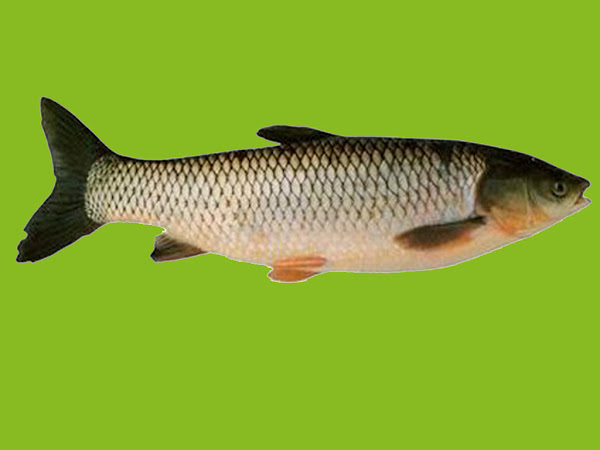
Uses
The Grass carp fish is cultivated mainly for food in many countries. And it is used for aquatic weed control in some countries.
Special Notes
The Grass carps grow very fast. Fingerlings stocked in the spring at 20 cm, will generally reach over 45 cm by fall. According to one study, average lifespan of these fish is between 5 and 9 years (with the oldest recorded surviving for 11 years).
There is a thriving population of Grass carp fish passing the 15 year mark in Silver Lake Washington. In natural condition, these fish require long rivers for the survival of the eggs and very young fish.
This fish may be baked, steamed, broiled and pan-fried for eating. However, review full breed profile of the Grass carp fish in the following chart.
| Name | Grass Carp |
| Kingdom | Animalia |
| Phylum | Chordata |
| Class | Actinopterygii |
| Order | Cypriniformes |
| Family | Cyprinidae |
| Subfamily | Leuciscinae |
| Genus | Ctenopharyngodon |
| Species | C. idella |
| Binomial Name | Ctenopharyngodon idella |
| Other Names | Known as White Amur in the United States |
| Breed Purpose | Food, aquatic weed control |
| Special Notes | Grow very fast, 5-9 years average lifespan, require long rivers for the survival of the eggs and very young fish in natural conditions, very common throughout the world |
| Breeding Method | Natural and artificial |
| Weight | Can grow around 40 kg |
| Water Type | Freshwater |
| Climate Tolerance | Almost all climates |
| Body Color | Dark olive, shading to brownish-yellow on the sides with a white belly |
| Rarity | Common |
| Availability | Worldwide |

